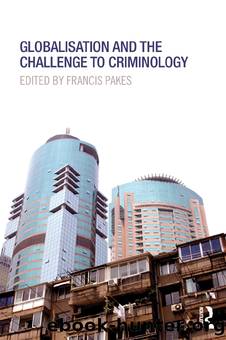Globalisation and the Challenge to Criminology by Francis Pakes

Author:Francis Pakes [Pakes, Francis]
Language: eng
Format: epub
ISBN: 9780415686075
Barnesnoble:
Publisher: Taylor & Francis
Published: 2012-11-29T00:00:00+00:00
The rise of crimmigration law
Prior to the mid-1980s, the immigration and criminal justice systems operated relatively autonomously. Immigration law operated primarily as a civil scheme with admission of noncitizens connected administratively and philosophically to enforcement of immigration restrictions. Deportation based on criminal convictions was generally reserved for âcrimes involving moral turpitudeâ or the specific crimes of murder, drug trafficking, and weapons trafficking.18
Similarly, while a noncitizenâs entry without inspection or unlawful re-entry had the potential to carry criminal consequences, these acts were generally handled through the administrative deportation system rather than through the criminal justice system. Using criminal enforcement resources to pursue individuals for border-crossing may have seemed outside of the mainstream of federal prosecutorsâ work. Unauthorized migration was an ingrained part of the cyclical nature of the seasonal agricultural economy, and it supplied labor to other industries. It also resulted from ordinary activity within long-established Mexican-American communities that were cross-sectioned by the border when it was drawn through them.
Immigration law in the United States has always ridden a pendulum between expansion and restriction of immigration, often depending on the magnetism of factors such as economic demand for labor or US involvement in international affairs. Beginning in the 1980s, the nature of immigration law began to change in a way that altered the course of that pendulum. Following the movement in criminal law away from rehabilitation and integration into society, immigration law took a turn towards a more retributive approach to immigration law violations, one that highlighted the outsider status of noncitizens. Criminal penology in the 1970s grew more punitive, lengthening sentences, emphasizing incarceration over social re-entry, and inventing civil consequences for criminal convictions such as loss of voting rights that stripped the earmarks of citizenship of those convicted of crimes.19 This sharper edge to criminal law may have been a means of asserting social control over elements of society considered to be outsiders because of their social status, class, or race.20
In the 1980s and continuing through the turn of the century, immigration law began to parallel the punitive trajectory of criminal penology in ways that tightened the interlacing of criminal and immigration law. The federal legislature passed laws targeting noncitizens that uniquely blended criminal law with deportation and immigration control.21 Enforcement of criminal laws affecting noncitizens became a high priority and the United States began to invest in higher detention and deportation levels. Law enforcement policies and practices brought to bear on migrants the apparatus of criminal enforcement, such as arrest, detention, and incarceration. Expanded discretion for law enforcement officials increased the level of contact between noncitizens and enforcers of criminal and immigration laws.22
At the same time, the constitutional procedural protections that have traditionally shielded criminal defendants from some of the excesses of government power failed to cross the boundary between immigration and criminal law.23 The right to counsel at government expense or to a jury trial, to protection from selfincrimination or to being tried twice for the same offense, or to the retroactive application of the law, among other procedural protections, are absent from the US deportation proceeding.
Download
This site does not store any files on its server. We only index and link to content provided by other sites. Please contact the content providers to delete copyright contents if any and email us, we'll remove relevant links or contents immediately.
Adding Value to Policy Analysis and Advice by Claudia Scott; Karen Baehler(456)
Sociological Perspectives of Health and Illness by Constantinos N. Phellas(445)
Race and American Political Development by unknow(441)
American Government and Politics Today by Steffen W. Schmidt Mack C. Shelley Barbara A. Bardes(429)
Human and Global Security : An Exploration of Terms by Peter Stoett(425)
Control Of Oil - Hardback by Kayal(409)
Entrepreneurship Education and Training: The Issue of Effectiveness by Colette Henry Frances Hill Claire Leitch(368)
The Catholic Church and European State Formation, AD 1000-1500 by Jørgen Møller(356)
Materializing the Middle Passage by Jane Webster;(352)
The World According to China by Elizabeth C. Economy(344)
Left Is Not Woke by Susan Neiman(328)
Turkey's Relations with the West and the Turkic Republics: The Rise and Fall of the Turkish Model by Idris Bal(313)
Theories of Counseling and Psychotherapy: A Case Approach by Nancy L. Murdock(313)
Cross-Cultural Child Development for Social Workers by Lena Robinson(308)
Japan's Ainu Minority in Tokyo by Mark K. Watson(297)
Advances in Child Development and Behavior, Volume 37 by Patricia J. Bauer(295)
Laboratory Life by Bruno Latour(294)
Beyond Service: State Workers, Public Policy, and the Prospects for Democratic Administration by Greg McElligott(285)
The Oxford Handbook of Museum Archaeology by Stevenson Alice;(275)
